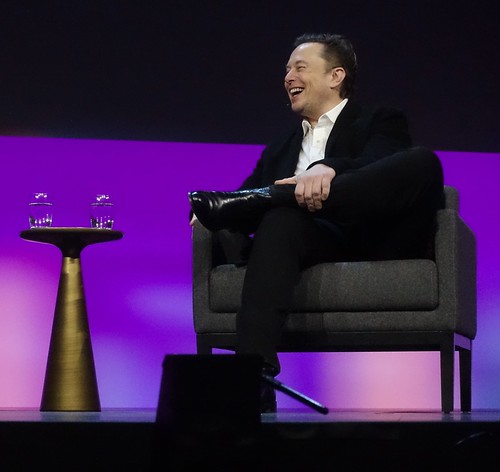
The new Mac Studio helped Apple’s computer shipments hit new records, but overall sales could slow now. CC-licensed photo by Roy Cohutta on Flickr.
You can sign up to receive each day’s Start Up post by email. You’ll need to click a confirmation link, so no spam.
A selection of 11 links for you. Semi-autonomous, prone to hovering. I’m @charlesarthur on Twitter. Observations and links welcome.
Snap Pixy review: a $230 drone with a camera buzzing around your head • WSJ
Joanna Stern:
»
The history of modern photography summarized:
• Humans invent selfies
• Humans invent sticks to capture wider selfies
• Humans invent little flying cameras to hover in front of them, because selfie sticks just weren’t cutting it.The $230 autonomous Snap Pixy is the latest of those little flying cameras, from the company behind the Snapchat app. It’s either a watershed moment in the struggle to overcome the anatomical restrictions of taking pictures of ourselves, or just a wacky toy. Either way, the Pixy is something totally new.
Unlike most recreational drones, the Pixy isn’t controlled via an app. It launches from your hand then hovers in front of you to capture video or photos. When it’s done with its brief flight, it returns to your palm.
“This basically is an experiment that ended up way better than we expected,” Snap Inc. Chief Executive Officer Evan Spiegel told me, adding that the company will be selling only a limited quantity of them starting Thursday.
You don’t need to be a Snapchat power user to find the Pixy intriguing. While it is designed to work with the popular social-media app, you can easily grab photos and videos and post them elsewhere. It isn’t the best quality footage, but the perspectives the Pixy captures are pretty cool.
I’ve been testing it for the past week and fielding questions from onlookers who wonder why a drone the size and shape of a grilled-cheese sandwich is following me around. Here are some answers.
«
Intriguing: it’s been ages since there was a new piece of hardware with the potential to properly interest people. You can imagine people standing on cliff edges and doing little up-and-back shots. Also, Stern only got about four flights per battery charge. Which isn’t a lot.
And this is what we want drones to do. Don’t make me learn how to fly it. Teach it how to fly itself.
unique link to this extract
Apple’s growth slows, but still beats Wall Street’s expectations • The New York Times
Tripp Mickle:
»
The pandemic has been a double-edged sword for Apple. Remote school and work spurred demand for computing equipment, and government stimulus checks and cutbacks in travel and leisure spending provided a jolt to the company’s all-important iPhone business, analysts said. But those same forces sowed supply-chain problems, triggering a global chip shortage that has cost Apple billions of dollars in missed sales.
The company’s challenges have been compounded by Russia’s war against Ukraine and rising coronavirus cases in China. Apple counts on Russia for 1% of its sales and a slightly larger percentage of its profit, analysts estimate. In China, where most of Apple’s products are assembled, one of the company’s key suppliers had to shut down production outside Shanghai.
During the January-to-March quarter, sales of iPhones, iPads and other devices rose 6.6% to $77.5bn, Apple said.
The bigger problem for Apple may come in the months ahead as economic strains from the war in Ukraine spill into Europe, said Gene Munster, a longtime Apple analyst and managing partner at the venture-capital firm Loup Ventures. “People are on edge,” he said. “They’re paying more for fuel. If you live in Germany, does that affect your decision to buy the next iPhone?”
«
Mac sales still booming to record levels (probably continuing to into this quarter), iPad sales just ticking over. Ironic if i’s the supply chain that’s the big problem, given that’s what Tim Cook solved so long ago.
unique link to this extract
Twitter says it overcounted its users over the past three years • TechCrunch
Sarah Perez:
»
In its earnings release, Twitter explains that it launched an account linking feature in March 2019 that allowed users with more than one Twitter account to link them together in its user interface, allowing them to more easily switch between their different identities. Those multiple accounts belonged to a single person, clearly, but continued to be counted as separate mDAUs — or “monetizable daily active users.”
The mDAU metric was already a self-invented, non-standard way of measuring users on the service. Twitter came up with the idea after struggling to show growth through measurements of monthly active users on a quarterly basis. Instead, it said the mDAU metric would represent users who logged in and accessed Twitter on any given day through its website and applications and who were able to view its ads. It noted, however, that the metric would not be comparable to similar daily active user disclosures from other companies, as they would often use a more expansive metric that included users who were not seeing ads.
This metric was meant to give advertisers a better idea of how many people on Twitter were eligible to be targeted with their marketing messages within a given time frame. And since advertising continues to fuel Twitter’s business, accounting for the majority of its revenue, it was an important metric in terms of Twitter’s health.
Unfortunately, it was wrong.
«
Overstated by between 1.4m to 1.9m, which is only a 1% difference. Better question: what metrics will be used once Musk is in charge? Growth at all costs?
unique link to this extract
Elon Musk’s two big goals for Twitter are totally at odds • Fast Company
James Surowiecki:
»
Musk seems to believe social-media platforms moderate content solely out of an ideological desire to restrict content they find problematic. And, as he tweeted on Tuesday, he thinks the answer is just to allow any speech that’s legal (or, as he put it, that “matches the law”). But the reality is much more complicated than that. The content-moderation decisions of companies like Twitter and Facebook are inevitably shaped by ideology. But simply eliminating content moderation isn’t an option, unless you want your site to become 4chan. Platforms moderate content mostly because they have economic incentives to do so: moderation makes their user experience more enjoyable to most people, and makes the platforms more appealing to advertisers, who generally don’t want their ads appearing next to a tweet by a Nazi or someone using the N-word.
To be sure, there’s an appealing simplicity to Musk’s solution: Let people say what they want, and let the chips fall where they may. But whatever you think of that approach in a philosophical sense, from a business point of view, making it easier for people to use racist and homophobic slurs, and to harass and dox people, will almost certainly cost Twitter more users than it will attract. It’ll also alienate many advertisers. And there’s another issue, which is that the European Union recently passed a law holding platforms responsible for hate speech and misinformation on their sites, and allowing the E.U. to issue fines equal to as much 6% of a company’s annual revenue. It’s totally unclear how an anything-goes approach to content moderation won’t quickly run afoul of the E.U. rules.
There’s a fundamental tension, in other words, between Musk’s insistence that people should be able to say what they want and what Twitter needs to thrive as a platform.
«
Plus, as he points out, the idea of charging a subscription doesn’t really work for the many people who aren’t in the western world, and would reduce the number of users.
unique link to this extract
I like free speech so much I’ve decided to buy it • McSweeney’s Internet Tendency
Eli Grober:
»
Hi there, I’m Elon Musk. I’m mostly known for rockets and cars, but what I really care about is free speech. I can’t get enough of it. In fact, I like free speech so much I’ve decided to buy it.
That’s right, it turns out free speech isn’t free—it costs exactly $44 billion. That might sound like too much money for one person to be allowed to spend, but that’s only because it is. And I’ve decided free speech is worth the cost. I’m going to make sure some board full of rich guys doesn’t get to define what counts as free speech. Instead, just one rich guy will get to decide what counts as free speech: me.
So what does free speech mean to me? Free speech means… well, anything you want it to mean. Free speech is magical. It’s amorphous. It’s undefinable. That’s the power of free speech: nobody in history has ever defined it—not our founders, or politicians, or judges, or even average citizens. There’s simply no definition of free speech.
“That’s not true,” you might say, “It’s pretty clearly defined.” And to that, I’d say, “That’s the beauty of free speech—it can be a lie. I was lying to you. And that’s allowed.”
And you might say, “That’s misinformation. Plus, private companies don’t have to abide by the more open standards of free speech allowed by the law. They have a responsibility to the public to curtail things like misinformation and prevent the incitement of violent acts like insurrections.” And to that, I’d say, “Blocked!”
«
Indispensable. (Via John Naughton)
unique link to this extract
Nigeria blocks 73 million mobile phones in security clampdown • Reuters
Kelechukwu Iruoma and Justice Nwafor:
»
Nigeria is among dozens of African countries including Ghana, Egypt and Kenya with SIM registration laws that authorities say are necessary for security purposes, but digital rights experts here say increase surveillance and hurts privacy.
Nigeria has been rolling out 11-digit electronic national identity cards for almost a decade, which record an individual’s personal and biometric data, including fingerprints and photo.
The National Identity Number (NIN) is required to open a bank account, apply for a driver’s license, vote, get health insurance, and file tax returns.
In 2020, Nigeria’s telecommunications regulator said every active mobile phone number must be linked to the user’s NIN. It repeatedly extended the deadline until March 31 this year.
The government said outgoing calls were being barred from April 4 here from any mobile phone numbers that had not complied.
Millions of Nigerians have not registered their SIM cards, for reasons ranging from concerns over privacy here to problems reaching registration centres or not having a NIN.
“There have been no reasonable explanations as to why we have to link NIN to our SIM,” said Nneka Orji, a journalist in southeast Nigeria who has not registered her SIM.
“For that reason, I am not ready to do that,” she told the Thomson Reuters Foundation.
«
Quietly creepy, rather like India’s Aadhaar system, which uses a 12-digit number to uniquely identify citizens.
unique link to this extract
Why the heck are SSNs still treated as passwords in the US? • TechCrunch
Haje Jan Kamps:
»
When I moved to the US a couple of years ago, my friends made sure that I knew I had to keep my Social Security number (SSN) secret and hidden. When I started opening a bank account and set up a cell phone plan, it became obvious why: All sorts of institutions that really should know better are treating this string of numbers as a password. There’s a huge, glaring problem with that. I maintain that Equifax should receive the corporate equivalent of capital punishment for allowing this to happen, but 145 million social security numbers were stolen by hackers a few years ago, which means that the Social Security numbers — yes, the same numbers that are being treated as “passwords” — for about half the U.S. adult population are in the wind.
We’ve gotten used to passwords by now, but at least, in most cases, passwords can be changed when they are hacked. Your social security number? Not so much. If your SSN leaks just once, you’re boned. It’s not possible to change it, and that brings up the true depth of idiocy in all of this: Relying on security that depends on keeping an unchangeable piece of information secret is really bloody stupid.
The corollary is this: Imagine that your email has been hacked but your email provider tells you that you can’t change your password, you can’t change your email provider, and you’ll just have to deal with it. That’s the situation we currently have with Social Security numbers.
Most countries have equivalents of a Social Security number that the state or the taxman uses to identify you. In most countries, however, it is never assumed that this number is secret. You log in to your bank accounts with it. You freely tell your employers what it is. You can spray paint it on the side of the house or tattoo it on your forehead. I would do neither, but that’s more a matter of my taste vis-a-vis forehead tattoos and garage graffiti. From a security point of view, there’s no particular reason why you shouldn’t.
«
I’d forgotten that besides having a sclerotic political gerontocracy, crumbling infrastructure and insane health service, the US also has a bizarre obsession with an inadequate form of identity.
unique link to this extract
NextSense wants to get in your ears and watch your brain • WIRED
Steven Levy:
»
[Konstantin] Borodin is now the lead ear spelunker for NextSense, which was born at Google and spun out of Alphabet’s X division. The startup’s focus is brain health—improving sleep, helping patients with epilepsy, and eventually enriching the lives of people with a range of mental conditions. The idea is to use its earbuds to capture an electroencephalogram, a standard tool for assessing brain activity. Just as an ECG tracks the fibrillations of the heart, an EEG is used to diagnose anomalies in brain activity. While some smart watches—Apple, Samsung, Fitbit—offer versions of an ECG and aim to spy on your sleep, collecting neural data has mostly been a can’t-try-this-at-home activity. Until now.
Standard EEGs are “a mess,” says Arshia Khan, a neurologist at the University of Minnesota, Duluth, who has done studies of those devices. To use the expensive machine in her lab, she has to fix electrodes to a person’s scalp. (“It leaves indentations on the head for a few hours, and if you use gel, it’s hard to shampoo it out.”) The device only works in a clinical setting and isn’t suitable for long-term studies. A handful of off-the-shelf, consumer EEG headsets are portable, but look incredibly awkward. If earbuds could deliver good results, that would be “fantastic,” she says. And not just for scientists.
For years, people have been shifting from tracking their health through sporadic visits to a doctor or lab to regularly monitoring their vitals themselves. The NextSense team is gambling that, with a gadget as familiar as an earbud, people will follow the same path with their brains. Then, with legions of folks wearing the buds for hours, days, and weeks on end, the company’s scientists hope they’ll amass an incredible data trove, in which they’ll uncover the hidden patterns of mental health.
«
The word “hope” in there is really holding up the entire ceiling, and not looking so great at it. Just as likely – sorry to be sceptical – is that they’ll end up with a ton of EEG data that is literally uninterpretable.
Have there been any successful spinouts from Alphabet’s X division? There was the “diabetics’ contact lenses” one, which retreated from that pretty fast. Others?
unique link to this extract
Climate change is making India’s brutal heat waves worse • MIT Technology Review
Casey Crownhart:
»
Extreme heat can be deadly, especially for a region where many lack access to cooling. And climate change is making heat waves more frequent and severe, with periods of hot days stretching out longer in places like South Asia.
This heat wave is particularly concerning for its timing and its spread, says Arpita Mondal, a climate researcher at the Indian Institute of Technology Bombay. Usually, peak temperatures in the region come in May and June, just before monsoon rains bring relief, she explains, but this year has been particularly hot, particularly early. March of this year was the hottest on record, with an average temperature of 33.1 °C (nearly 92 °F).
The problem is also widespread across the country, affecting not only the typical hot spots in the northwest and southeast but also regions that aren’t used to seeing so much extreme heat, Mondal says. And the effects are even more stark because of a lack of rainfall so far this season.
“It’s part of a broader climate-change signal,” says Amir AghaKouchak, a climate researcher at the University of California, Irvine. India’s average annual temperature increased at a rate of 0.62 °C per 100 years between 1901 and 2020, according to data from the World Bank. And maximum temperatures have climbed even more quickly, at a rate of 0.99 °C every 100 years.
“People think a degree or two might not matter,” AghaKouchak says, but when average temperatures increase by even small amounts, it means extreme events are becoming more likely.
«
The danger is in the “wet bulb” temperature – when it’s humid and hot, because then the body can’t cool through sweating. Kim Stanley Robinson’s book “The Ministry For The Future” begins with a devastating heatwave in an Indian village. (I found it too optimistic about our capacity to fix things, but the disasters were believable.)
unique link to this extract
Mark Zuckerberg says employee attrition will make Facebook better • Business Insider
Kali Hays:
»
Mark Zuckerberg just admitted that more workers are leaving Facebook. He just doesn’t see that as a bad thing.
“I don’t think this sort of volatility , that companies can face, is always that unhealthy for making sure you have the right people,” the founder and CEO said on a call to discuss Facebook’s first-quarter results.
Insider has reported on the company’s retention problems, with some tech workers now saying Facebook can be a “black mark” on their resumes.
Zuckerberg said on Wednesday that employee attrition can ultimately ensure that the right kinds of people stick with the company as it begins a risky shift to building the metaverse.
“During Covid, we saw the attrition level go down a lot because people didn’t want to get new jobs, which probably meant that a lot of people stayed at the company that didn’t care that much about what we were doing, compared to what we would have wanted,” Zuckerberg added. “And I’m just trying to lead the company in a way where we position ourselves as the premier company for building the future of social interaction and the metaverse, and if you care about those things, we’re getting the best people to come work here.”
David Wehner, Facebook’s CFO, said “attrition has stepped up” since the height of the pandemic, insisting that it is “broadly consistent” with the number of people who would leave the company before the pandemic.
«
On that basis, shouldn’t Facebook get rid of all of its staff, at which point it would be the best possible company?
In adjacent news, Reality Labs (the metaverse division) lost $2.9bn in the quarter on income of $695m – so the loss is up from $1.83bn, but revenue is up from $534m. So losses grew by $1.1bn while revenues grew by $160m.
I think it would be better as a skunkworks. It’s trying to push an iceberg uphill.
unique link to this extract
Fictosexual man who married hologram says he can’t communicate with her anymore • Fox5NY
»
A Japanese man who married a fictional, computer-synthesized pop singer four years ago now says he can’t communicate with her but still loves her.
According to the Japanese newspaper The Mainichi, Akihiko Kondo, 38, said he hit a technical roadblock with Hatsune Miku after the company that provides the artificial intelligence and hologram to communicate with her was no longer providing the service.
Kondo would communicate with Miku using a three-dimensional hologram of the pop singer projected into a cylinder.
“My love for Miku hasn’t changed,” he told Mainichi. “I held the wedding ceremony because I thought I could be with her forever.”
Kondo, who lives in suburban Tokyo, identifies as ‘fictosexual’- someone who is sexually attracted to fictional characters. He has shared details about his relationship with the world to promote the growing lifestyle.
“It’s not that people can’t live in society because they’re engrossed in a two-dimensional world, but rather, there are cases where people become captivated as they search for a place for themselves in video games and anime, because reality is too painful for them. I was one of those people,” said Kondo to Newshub.
«
Everything is an episode from Black Mirror, isn’t it? Or a combination of them.
unique link to this extract
| • Why do social networks drive us a little mad? • Why does angry content seem to dominate what we see? • How much of a role do algorithms play in affecting what we see and do online? • What can we do about it? • Did Facebook have any inkling of what was coming in Myanmar in 2016? Read Social Warming, my latest book, and find answers – and more. |
Errata, corrigenda and ai no corrida: none notified






:format(webp):no_upscale()/cdn.vox-cdn.com/uploads/chorus_asset/file/23402060/ebay_sales_homepod.jpg)



